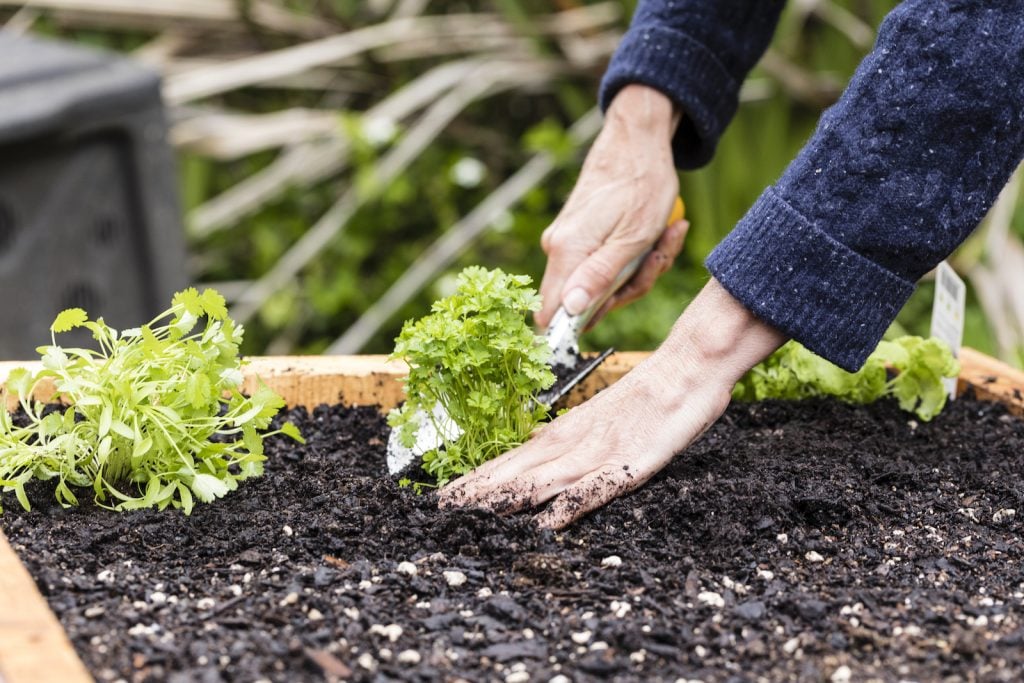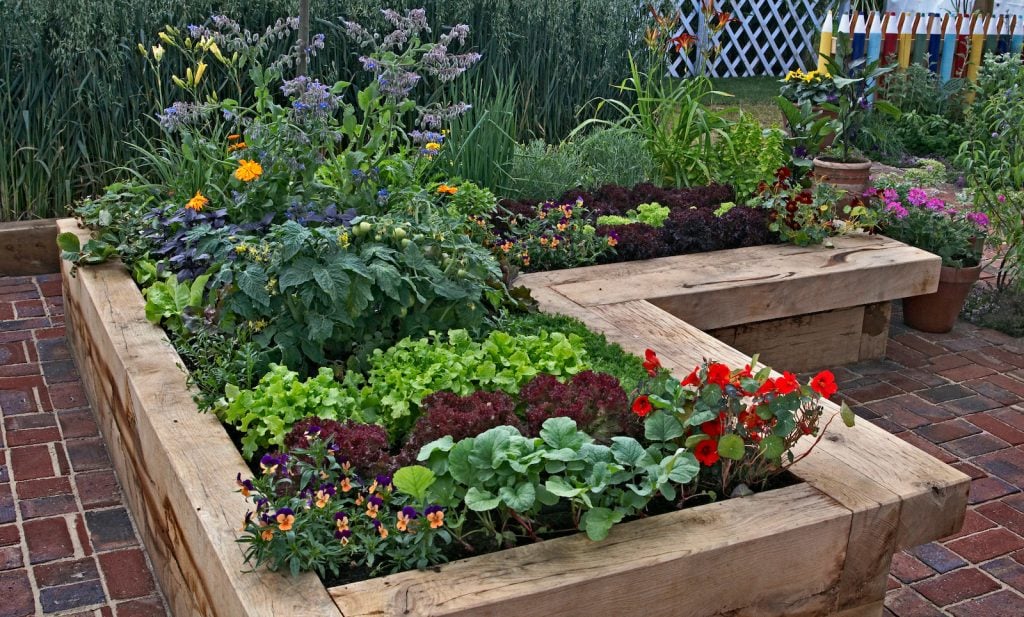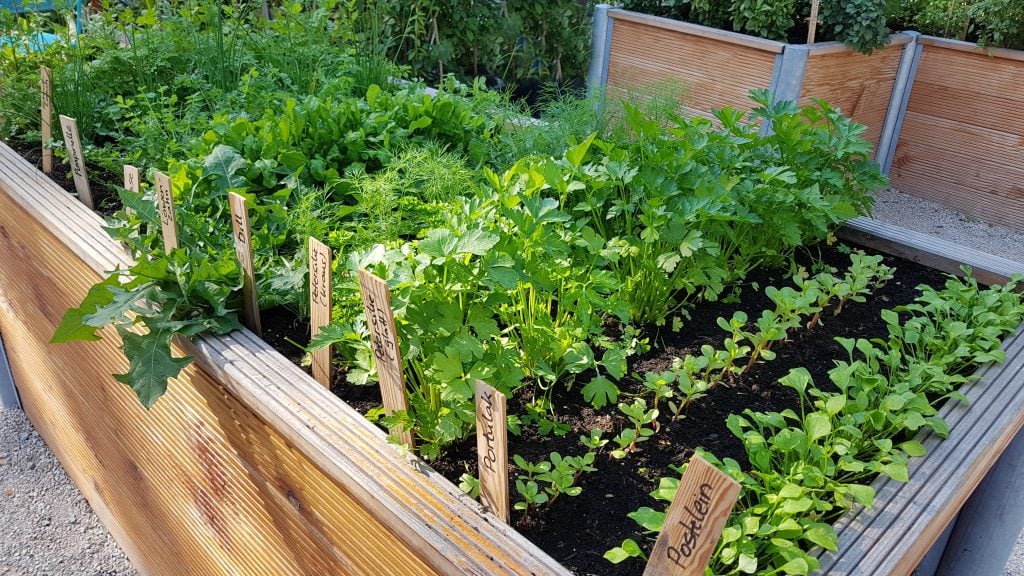Knowing what soil to put in raised beds can make a big difference to the quality of the produce or plants you’re intending to grow. And good raised bed soil is the foundation for every healthy and thriving garden.

In this guide we’ll cover the advantages of growing in a raised bed, how much soil you’ll need, how raised bed soil differs from normal garden soil and other topics that will ensure you get the best from gardening using this popular method.
What is a raised bed?
Let’s start with the basics. If you’re unfamiliar with raised beds, they are a form of gardening in which the soil is raised above ground level, with most of this soil being enclosed by some sort of frame. They can range in height from just a few inches to waist height and even higher.
Stone, brick, paving slabs, timber and precast concrete are all commonly used materials used for constructing raised beds. To make life easier, wooden raised bed kits are also available, with timber boards that are pre cut, predrilled, sanded and pressure-treated for a longer life.

Almost any kind of plant can be grown in raised bed soil, including most types of vegetables, soft fruits, alpines requiring good drainage and, depending on the size of the bed, small trees and shrubs. They can also be used as a cutting garden for cut flowers.
The advantages of raised bed gardening
Beyond just good looks, there are a lot of benefits to doing your gardening in a raised bed, especially when it comes to plant health and the condition of the raised bed soil.
- Less weeding – weeds will have little room to grow in a densely planted raised bed. And when they do appear, the bed’s loose, rich soil makes them easier to pull up.
- Fewer pests – it’s easier to cover raised beds fabric or other covers to prevent insect infestation.
- Increased soil temperature – the soil in a raised bed is more free draining, so will heat up quicker in springtime, which is ideal for sowing and growing vegetables.
- Better root health – a raised bed soil mix containing organic matter, fertiliser and rich top soil will provide excellent conditions for healthy root growth.
- Ideal for specialised plants – you can choose the raised bed soil to match the plants you’re looking to grow, gritty compost for mediterranean plants, for example, or ericaceous compost for acid-loving plants.
- Improved access – for gardeners with mobility problems, raised beds are easier to manage as they involve less bending and reaching.
What’s the difference between garden soil and raised bed soil?
For successful growing, it’s important to understand the difference between garden soil and raised bed soil. Ignoring this difference could very well lead to inferior produce or plants.
A significant difference is the amount of moisture and heat these two soils require to break down organic materials.
Another is the amount of humus present. This is the dark organic material in soils generated when plant or animal matter decomposes. And the more humus there is in the soil, the more effective it becomes for growing plants and vegetables.

Although garden soil breaks down organic matter more quickly, thus producing more humus, it is far from ideal for raised beds.
That’s because the size of the particles found in garden soil are too dense, meaning it over-compacts and has a tendency to become oversaturated with moisture, leaving very little space for roots to grow.
Due to its high moisture content, garden soil can also contain a comparatively high volume of salts, making it corrosive.
So, although it’s rich in nutrients, you should not use garden soil to grow vegetables and plants in a raised bed. Read on to discover the best recipe for raised bed soil composition.
The perfect raised bed soil mix
Gardeners with experience of growing in raised beds will most probably have their own tried and tested recipe for the mix of soil they use. Look online and you’ll find that opinions differ when it comes to what soil to put in raised beds.

Read more : How to Make Homemade Grass and Weed Killers
However, it’s generally accepted that the optimum raised bed soil mix includes a blend of topsoil, compost and organic matter.
Top soil
Comprising around 50%, the bulk of your raised bed soil mix should be premium grade topsoil. Although this loamy grade isn’t usually cheap, it is high in fertility, has good structure and should not contain weeds.
If your beds are large and you require a lot of topsoil, it may be worth buying it in bulk from a specialist supplier. Smaller raised beds can be filled with bags of topsoil purchased from DIY stores or garden centres.

If possible, you should check the topsoil before you buy to ensure it doesn’t contain any stones, fibrous roots, weeds or even contaminants such as glass or bricks. You should also ask where the supplier obtained it from. For example, topsoil from building sites can vary in quality or be too compacted.
Compost
Compost is an essential ingredient in any soil mix for raised beds. It will hold moisture and provide key nutrients for your plants and vegetables. So it should make up around 30% of your raised bed mix.
If you don’t have your own compost heap, or you just don’t have enough, you’ll find a wide range of composts at your local garden centre. There are many different types, but we’d recommend using a peat-free compost.
As peat is sourced primarily from increasingly rare lowland bogs, peat-based products do have a negative impact on the environment.
Organic matter
Adding 20% organic matter to your raised bed soil will make it less compact and more workable. It will also improve the soil structure, providing more tiny pockets in the soil to hold water and air, which will stimulate root growth and help the plants thrive.
There’s a wide choice of organic mediums you can choose from, including leafmould, grass clippings, well-rotted horse manure or composted wood and bark chips.
Materials for improving drainage
If your raised bed is placed on an existing lawn or border, drainage will not be a problem. However, if it sits on paving or concrete, you should add material at the base to improve drainage, such as stones, rubble or broken crocks.
You could also add sharp sand to the mix. This washed, gritty sand will drain freely yet hold some water to sustain plants. Sharp sand can be found in garden centres, but do not confuse it with builders’ sharp sand, which is a different material altogether.

For specialist beds, those used for growing bulbs, such as onions or alpines for example, will need even more drainage. In which case, draining can be further improved by adding grit to the raised bed soil mix.
How much soil will you need?
Having the right amount of soil for your raised beds will make the best use of the space and ensure vegetables and plants have the space they require to thrive. Knowing exactly how much you need will also save you both time and money.
To calculate the amount of soil you’ll need for a rectangular raised bed you’ll only need to take three measurements:
- Width (W)
- Length (L)
- Depth of soil required (D)
The volume (V) of soil can be calculated using this formula:
V = L x W x D
First measure the length, width and height of your raised bed. Unless the boards you’ve used to construct your bed are very thick, it doesn’t matter if the measurements are taken from the inside or outside.
Read more : Paula Deen’s Cream Cheese Pound Cake
As most topsoil and compost is sold in metric volumes, either litres or cubic metres (m3) it‘s best to take the measurements in metres.
So, for example, if your raised bed is 1.2m wide, 2.4m long and the soil needs to be 30cm deep, the calculation would be:
1.2 x 2.4 x 0.30 = 0.896m3
This means a bag or bulk delivery of 1 cubic metre would be required.
Maintaining the soil in your raised bed
Once established, it’s important to maintain the health of your raised bed soil.
Signs of a healthy soil include a loose granular structure and quite a dark colour, which will depend on the organic matter present. It should also be well-drained but still moist.

There are three simple steps you can take to maintain soil health, not only in a raised bed but other areas of your garden.
Avoid compaction
Compacted soil increases density by removing air pockets and impairing its structure. This makes it difficult for roots to grow by limiting their access to water, air and nutrients.
To avoid compaction, make sure you never step or kneel on the soil in your raised bed. It’s easier to do this if your raised bed is less than four feet wide.
Add organic matter
Unlike garden soil, the nutrients in the soil of your raised bed will diminish over time.
So every spring add some organic matter, which is a great source of slow-release plant nutrients. Doing this will also enhance soil structure and attract beneficial organisms.
Cover the soil
This is especially beneficial in winter as uncovered soil is susceptible to erosion from rain, wind and frost, which will lead to a loss of organic matter, reduced water penetration.
Mulching with straw or leaves to cover the soil is another option, as they both decompose relatively quickly and add nutrients over time.
Final thoughts
Raised beds are a great way of growing a wide range of plants, particularly fruit, such as strawberries and grapes and vegetables, such as courgettes and tomatoes.
They are also a good way to introduce a different soil type to your garden and are ideal for gardeners with reduced mobility.

But your success in growing does depend on knowing the best soil for raised beds. We hope this guide has shown you the way and that your plants and produce flourish.
If you would like any further advice on raised bed soil, please get in touch.
Source: https://gardencourte.com
Categories: Recipe


